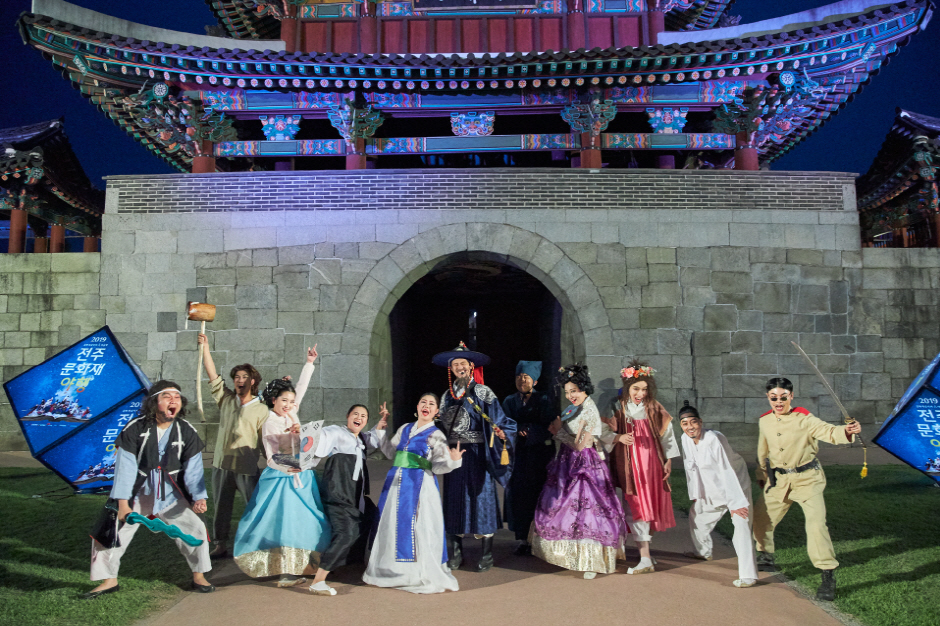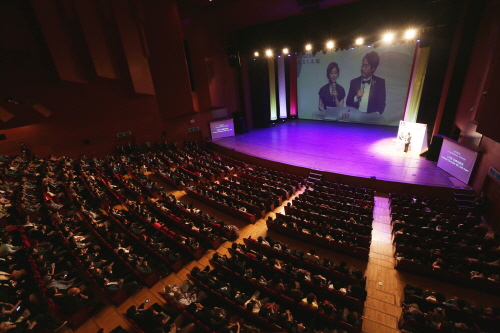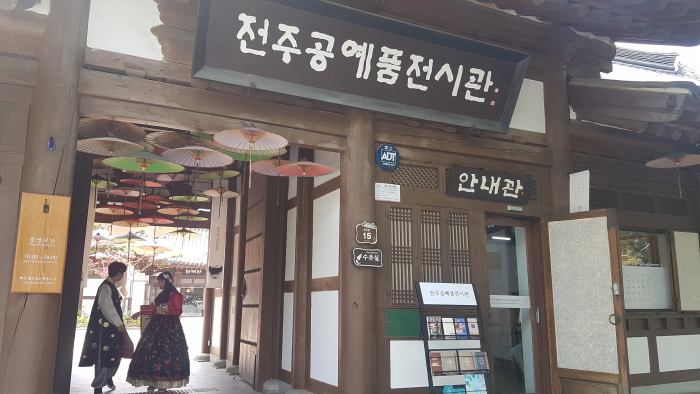Voyage nocturne à Jeonju (전주 문화재야행)
401.99272697760114m 6653 2024-04-07
44, Taejo-ro, Wansan-gu, Jeonju-si, Région Jeonbuk
+82-63-232-9937
<Le voyage nocturne à Jeonju (Jeongjuyahaeng, 전주야행夜行)>
Ce programme vous permet d'apprécier les centaines de hanok du village de Jeonju et ce au clair de lune. Le voyage nocturne à Jeonju permet ainsi d'apprécier les principaux patrimoines culturels de la ville de Jeonju. Ce programme vous permet de découvrir les histoires cachées de la ville de Jeonju et son patrimoine culturel dans sa globalité.
Sanctuaire de Gyeonggijeon (경기전)
416.36844909040923m 6382 2024-04-08
44, Taejo-ro, Wansan-gu, Jeonju-si, Région Jeonbuk
+82-63-281-2790
Le sactuaire de Gyeonggijeon a été élevé en 1410 pour abriter le portrait du roi Taejo, fondateur de la dynastie Joseon. Ce lieu saint comporte Jinjeon où se trouve le portrait, et Jogyeongmyo abritant les plaques commémoratives de Han Lee et de sa femme, ancêtres de la famille royale Lee de Jeonju. Détruit en partie durant l’invasion des forces japonaises (1592-1598), le Gyeonggijeon qui existe actuellement a été rénové en 1614.
Fine day [Korea Quality] / 좋은날 [한국관광 품질인증]
447.388523799632m 7981 2024-04-07
37-7, Jeondongseongdang-gil, Wansan-gu, Jeonju-si, Région Jeonbuk
+82-10-2607-3326
Good Day is a traditional Korean house situated in Jeondong Catholic Cathedral Street in Wansan-gu, Jeonju, Jeollabuk-do. It was originally built in 1942 and remodeled in 2011 as a guesthouse by the current owner. The guesthouse has most of the features of a traditional Korean house still intact, but with modern amenities added for the comfort of the guests. The floor, walls, and ceiling are coated with red clay, and the ceiling rafters are visible as in most traditional Korean houses. Many guests say that sleeping in a room made of these natural materials helps them relieve fatigue. The rooms are well-insulated and warm for the cold winter days. The guesthouse is close to Gyeonggijeon Shrine, which enshrines a portrait of Taejo Yi Seong-gye, the first king of Joseon, and is conveniently located for those wishing to take a tour of Jeonju Hanok Village featuring hundreds of traditional Korean houses, Omokdae, and Jeondong Catholic Cathedral. In addition to these tourist attractions, there is also a traditional marketplace called Nambu Market with lots to eat and see. The guesthouse owner named it "Good Day" because he wishes all his guests to have a good day during their stay. He decorated every corner of the guesthouse with this in mind. The grass yard and colorful garden are beautiful throughout the seasons. The garden includes a mix of wild flowers, pine nut trees, fig trees, pomegranate trees, grape vines, and jujube trees. The “toetmaru (open living room with wooden floor)" right in front of the garden is also decorated with small flowerpots. The “toetmaru” is the most popular place among the guests because it’s a great place to enjoy the sun and breathe in the scent of flowers. On a rainy day, you can hear the raindrops falling down the eaves. There are six guestrooms at the guesthouse, named "Spring Waltz,” “Summer Tiffany,” “Autumn Pomegranate,” “Winter Festival”, "Sunshine", and "Welcome." The ceiling rafters are visible in all the rooms as in most of traditional Korean houses. The rooms are furnished with TV, refrigerator, and air conditioner. The bathroom comes with shower booth and bidet. People of different age groups come to stay at this guesthouse, and most of them say the guesthouse is clean and comfortable to stay in, thanks to the owner who sun-dries the sheets and blankets on the rooftop, cleans the rooms, and cultivates the garden every day of the year to make sure that the guests can have a comfortable, memorable stay. The guesthouse is conveniently located near a number of tourist destinations as well.
Blueboat guest house Jeonju [Korea Quality] / 블루보트게스트하우스 전주점 [한국관광 품질인증]
478.3707908704688m 764 2024-04-07
2nd floor, 75, Chunggyeong-ro, Wansan-gu, Jeonju-si, Région Jeonbuk
+82-10-6545-9049
'Blueboat Hostel Jeonju is one of guesthouses of the 'The Guest House' chain in Busan, Seoul, and Gyeongju. Blueboat Hostel Jeonju opened in April 2016 in Gyeongwon-dong, Jeonju-si, which is only 10 minutes away from Gyeonggijeon Shrine on foot. A number of other popular tourist destinations including Jeonju Hanok Village, Jeongdong Cathedral, and Nammun Market are also within walking distance. The hostel has seven guestrooms furnished with steel frame beds. The bathrooms and kitchen are shared among the guests, and there is a television in the kitchen. The rooms have a trendy interior design because it's mostly visited by young tourists. The guesthouse is just like one of those you can find in other countries, except cleaner.
Festival International du Film de Jeonju 2019 (전주 국제영화제 2019)
583.7817748652288m 5599 2024-04-07
46, Jeonjugaeksa 4-gil, Wansan-gu, Jeonju-si, Région Jeonbuk
Secrétariat de Jeonju +82-63-288-5433
Le Festival International du Film de Jeonju, excitante combinaison entre le plaisir et le cinéma, est une fantastique sortie printanière de neuf jours proposant un grand nombre d’évènements et de films. Il se tient sur la « Movie Street » (Gosa-dong, Jeonju), une rue bourrée de cinémas. Durant les festivités, les rues s’animent de cette énergie contagieuse et de l’enthousiasme des aficionados. Venez vous amuser ce printemps durant la fête du cinéma de Jeonju !
Siwon [Korea Quality] / 시원 [한국관광 품질인증]
585.1717366505849m 11550 2024-04-07
45-41, Omokdae-gil, Wansan-gu, Jeonju-si, Région Jeonbuk
+82-10-6520-7840
Situated within Jeonju Hanok Village, Siwon is a hanok experience hall designated by the local government. The names of its individual rooms carry such meanings as “a wish for a life full of love, health and joy”. Each room (except the Gadeukbang) has a small attic where guests can have fun climbing up and down a ladder.
The clay structure with a wood shingle roof is the source of many fond memories for the owner, a permanent fixture of the village, who was born and grew up in the house. The house was once called “the house of persimmon trees in Ssangsiam alley”.
Although the framework of the house was completed in 1954, it has only been open to tourists since it was repaired and renovated in 2014. The house has been fully insulated against draughts and sound-proofed, transforming into a comfortable, cozy guest house that retains the unique beauty of a traditional Korean hanok.
The house’s yard contains a small flower garden and a swing, as well as a space where guests can play tuho, a traditional game in which the players try to throw sticks into a canister, jaegichagi, and other traditional games. In addition, guests can try their hand at woodcraft by cutting and carving pieces of wood into artworks of their own making.
A number of attractions are within walking distance of Siwon, including Gyeonggijeon Shrine, which contains the portrait of King Taejo Seong-gye Yi, the founder of the Joseon Dynasty; Jeondong Cathedral, which features a European architectural design; Omokdae, where King Taejo defeated the Japanese army and held a banquet; Jeonjuhyanggyo Local Confucian School; Namcheon Bridge and Cheonyeonru Pavilion; Nambu Market, a foodies’ paradise; and the Youth Mall
Centre d'exposition de l’artisanat traditionnel de Jeonju (전주공예품전시관 전주명품관)
586.6579775573113m 4112 2024-04-07
15, Taejo-ro, Wansan-gu, Jeonju-si, Région Jeonbuk
+82-63-282-8886
Le centre d’exposition de l’artisanat traditionnel de Jeonju permet non seulement aux visiteurs de découvrir la beauté de l’artisanat traditionnel coréen, mais aussi de créer leurs propres créations. Le centre abrite un hall d’exposition, un hall spécial et un hall pour les activités. C’est dans le hall des activités que les visiteurs peuvent créer leurs propres pièces : feuilles de papier de riz, poterie, meunuiserie, broderie etc. Par ailleurs, dans le magasin d’artisanat il est possible d’acheter des pièces faites par des professionnels.
Jeonju hanok house [Korea Quality] / 전주한옥숙박체험관 [한국관광 품질인증]
620.8319635239247m 1623 2024-04-07
56-1, Eunhaeng-ro, Wansan-gu, Jeonju-si, Région Jeonbuk
+82-10-3659-0055
Jeonjuhanok Korean House is a traditional Korean house built more than 60 years age, and it was recently remodeled for visitors to see and experience an old traditional Korean house. It’s conveniently located on the street called "Eunhaeng-ro" right in the middle of Jeonju Hanok Village for those visiting the area to take a tour of the hanok village. Although it's in the middle of the village, it's quiet inside because it's located at the end of a long, wide alley, which has the feel of an art gallery thanks to the lighting. There is a table in the yard in front of the ‘ㄱ’-shaped house. Behind the house is a café where breakfast is served. The house has an open space between the rooms called "toetmaru", which serves as a living room as in all traditional Korean houses. It’s where Koreans used to rest under the warm sunlight in the old days. The guests must pass through this "toetmaru" to get to the roms.
Jeonjuhanok Korean House has seven "ondol (floor-heated)” rooms with a loft. The rooms are clean and have a simple interior with a wooden ladder to the loft, which is a favorite place for most kids staying here with their parents. Each guestroom is furnished with a water purifier. The guesthouse serves toast, caffe Americano, fruits, and tea for breakfast.
Samrockhon [Korea Quality] / 삼락헌 [한국관광 품질인증]
638.6072387023468m 7345 2024-04-07
47-8, Eunhaeng-ro, Wansan-gu, Jeonju-si, Région Jeonbuk
+82-10-7799-7358
Samllakheon is located in the center of Jeonju Hanok Village which is the highlight of traveling in Jeonju. Samllakheon has been opened newly by the owner husband and wife who are running Bugyeongdang, a lodging in traditional Korean style house. The building of Samllakheon used to be the etiquette training center of Jeollabuk-do Province, and its size is much larger and more magnificent than ordinary houses and its style is very antique. The arrangement of the houses, the pillars, rafters, crossbeam and the ridge of the roof are clearly different from those of ordinary houses. The garden covered with pebbles and rocks and the well-tended flower bed are also worth seeing.
The rooms are composed of the five rooms of Spring, Summer, Fall, And, & Winter. Every room has a duplex attic under the high ceiling and a warm and clean restroom. The guests can help themselves with coffee, tea, toast, etc. for breakfast from the communal mini kitchen. The guests of Samllakheon can have 50% discount on Korean traditional clothes and 30% discount on rent of electric bike. It is also possible to experience traditional culture including making Injeolmi rice cake, Korean paper art, pottery and fragrant purse by making a reservation in advance.
The owners of the house can give information on Jeonju Hanok Village, many other tourist attractions and famous restaurants in Jeonju area. Major tourist attractions within walking distance are Jeondong Catholic Church, Gyeonggijeon, Gyodong Art Center, Choi Myung-Hee Literature Center, Omokdae, Jeonju Hyanggyo, Pungnammun Gate nd Nambu Market & Youth Mall.
Yeohangga [Korea Quality] / 여행가 [한국관광 품질인증]
645.4940771696163m 9718 2024-04-07
74-11, Eunhaeng-ro, Wansan-gu, Jeonju-si, Région Jeonbuk
+82-63-231-3040, +82-10-7742-6738
Yeohangga is a guesthouse owned and run by a woman who majored in early childhood education and who has been teaching children for over 20 years. The name means "A home for a happy trip," she says. It’s a unique guesthouse since the owner offers various traditional educational games. The cozy and comfortable guesthouse is a traditional Korean house built in March 2013 at a site where an old house used to be. The main building and detached building are divided by the ridge of the roof with beautiful rafters. There is another meaning to the name of the guesthouse: "a house where the woman is happy." She named it as such for a good reason. She used to live in Seoul when her parents advised her to move to Jeonju and run a guesthouse, leaving her husband and child behind. At first, she considered accepting only female guests, but it wasn't an option since most of the people visiting Jeonju are couples and groups of friends. Instead, she made sure the guesthouse is safe for women while building the house. Many female tourists traveling alone find this a great feature of the guesthouse because they feel safer during their stay. For one, she installed three doors for the rooms (1 transparent door, 1 opaque glass door, and a traditional Korean door). Not only do the guests feel safer; the rooms are also well-insulated thanks to the triple doors. The floors and walls are covered with traditional Korean paper coated with soybean oil, which is very environment-friendly. In the four rooms named “Spring,” “Summer,” “Autumn,” and “Winter,” there are many toys and materials for traditional Korean cognition games, such as “Chilgyo Game,” “Gonu Game,” and “Mabangjin.” It’s very likely that even Koreans have never heard of these games. The owner of the guesthouse chose these games specifically because they are perfect for children to play in a traditional Korean house. She teaches her little guests how to play the games. “Chilgyo Game” involves making a shape with 7 to 20 pieces, whereas “Gonu Game” is similar to the game of Chinese chess. "Mabangjin" is a type of IQ game that involves laying down a total of nine different numbers in three rows and columns so that the sum of the three numbers is identical when added horizontally, vertically, or diagonally. Many guests find these games interesting, and the owner of the guesthouse finds joy in teaching these games to as many families as possible. She recently took over another traditional Korean guesthouse called "Samrakheon" near the Jeonju Oriental Medicine Center. It's a stand-alone guesthouse for groups and families, and she uses the place to teach traditional games to more people.


![Fine day [Korea Quality] / 좋은날 [한국관광 품질인증]](http://tong.visitkorea.or.kr/cms/resource/89/2597389_image2_1.jpg)

![Siwon [Korea Quality] / 시원 [한국관광 품질인증]](http://tong.visitkorea.or.kr/cms/resource/24/2596624_image2_1.jpg)

![Jeonju hanok house [Korea Quality] / 전주한옥숙박체험관 [한국관광 품질인증]](http://tong.visitkorea.or.kr/cms/resource/90/2531490_image2_1.jpg)
![Samrockhon [Korea Quality] / 삼락헌 [한국관광 품질인증]](http://tong.visitkorea.or.kr/cms/resource/02/2596602_image2_1.jpg)
![Yeohangga [Korea Quality] / 여행가 [한국관광 품질인증]](http://tong.visitkorea.or.kr/cms/resource/63/2572563_image2_1.jpg)
 Français
Français
 한국어
한국어 English
English 日本語
日本語 中文(简体)
中文(简体) Deutsch
Deutsch Español
Español Русский
Русский